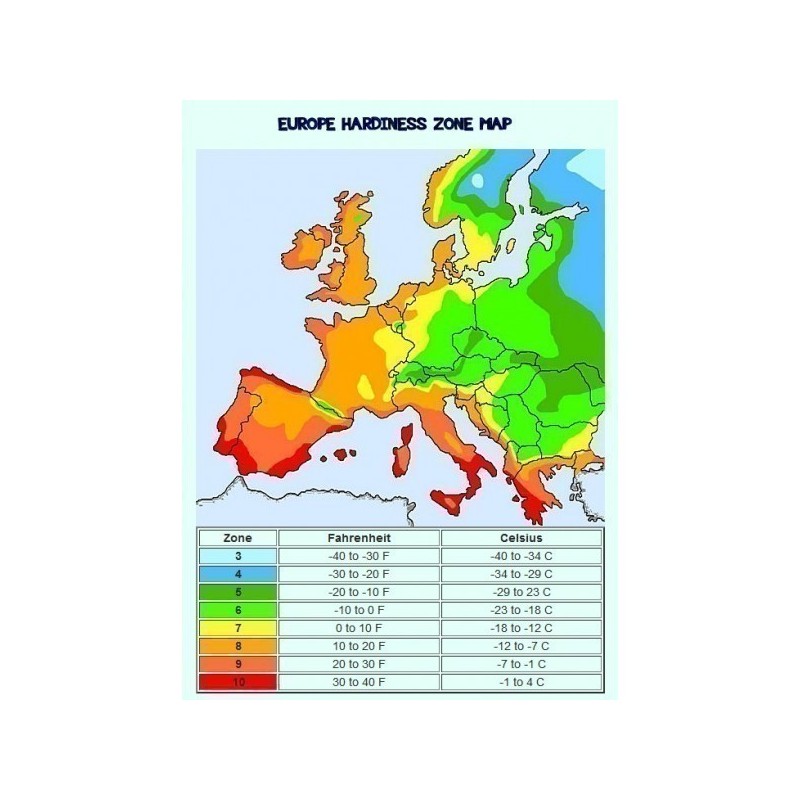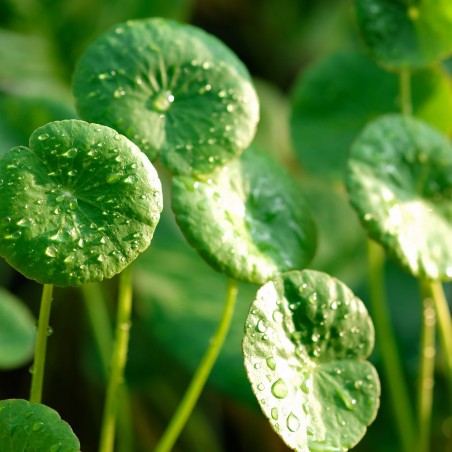
Hardiness Zones
| Zone | untere Grenze | obere Grenze |
| 1 | - - - | unter -45,5° C |
| 2 | - 45,5° C | - 40,1° C |
| 3 | - 40,0° C | - 34,5° C |
| 4 | - 34,4° C | - 28,9° C |
| 5 | - 28,8° C | - 23,4° C |
| 6 | - 23,3° C | - 17,8° C |
| 7 | - 17,7° C | - 12,3° C |
| 8 | - 12,2° C | - 6,7° C |
| 9 | - 6,6° C | - 1,2° C |
| 10 | - 1,1° C | + 4,4° C |
| 11 | + 4,5° C | + 10,0° C |
| 12 | ab 10,1° C | - - - |
European cities
The table herein provides hardiness zone data for some European cities (based on climatological data):
| City | Zone | City | Zone | |
|---|---|---|---|---|
| Amsterdam, The Netherlands | 8 | Antwerp, Belgium | 8 | |
| Belfast, Northern Ireland | 9 | Berlin, Germany | 7a | |
| Bratislava, Slovakia | 7a | Bucharest, Romania | 6a | |
| Cardiff, Wales | 9 | Catania, Italy | 10 | |
| Copenhagen, Denmark | 7a | Cork, Ireland | 9b | |
| Dublin, Ireland | 9 | Düsseldorf, Germany | 8 | |
| Edinburgh, Scotland | 8 | Gdańsk, Poland | 7 | |
| Glasgow, Scotland | 9a | Hamburg, Germany | 7 | |
| Helsinki, Finland | 5b | Istanbul, Turkey | 8b | |
| Kaliningrad, Russia | 6 | Kiev, Ukraine | 5 | |
| Kraków, Poland | 6 | Lisbon, Portugal | 10a | |
| Ljubljana, Slovenia | 7 | London, England | 9a | |
| Madrid, Spain | 8-9 | Málaga, Spain | 10b | |
| Marseille, France | 9 | Milan, Italy | 7-8 | |
| Minsk, Belarus | 5а | Moscow, Russia | 4 | |
| Munich, Germany | 6 | Murmansk, Russia | 5 | |
| Nicosia, Cyprus | 10b | Oslo, Norway | 6 | |
| Simferopol, Ukraine | 7a | Palma, Spain | 10 | |
| Paris, France | 8a | Poznań, Poland | 7a | |
| Prague, Czech Republic | 7a | Reykjavík, Iceland | 7 | |
| Riga, Latvia | 6 | Rome, Italy | 9b | |
| Rovaniemi, Finland | 4 | Saint Petersburg, Russia | 5a | |
| Sarajevo, Bosnia and Herzegovina | 7 | Santander, Spain | 10a | |
| Simrishamn, Sweden | 8a | Sochi, Russia | 9 | |
| Sofia, Bulgaria | 6 | Stockholm, Sweden | 6a | |
| Strasbourg, France | 7 | Tallinn, Estonia | 5 | |
| Tuapse, Russia | 8 | Tórshavn, Faroe Islands | 7-8 | |
| Tromsø, Norway | 7 | Trondheim, Norway | 6 | |
| Umeå, Sweden | 5 | Vienna, Austria | 6-7 | |
| Vilnius, Lithuania | 5 | Vorkuta, Russia | 2 | |
| Valletta, Malta | 10b | Warsaw, Poland | 6 | |
| Zürich, Switzerland | 7 |


Su agradecimiento a la reseña no pudo ser enviado
Reportar comentario
Reporte enviado
Su reporte no pudo ser enviado
Escriba su propia reseña
Reseña enviada
Su reseña no pudo ser enviada
🌍 Envío Global desde la Unión Europea
Realizamos envíos a todo el mundo desde la Unión Europea mediante correo certificado con acuse de recibo.
📦 Seguimiento del Pedido
Inicia sesión en tu cuenta y ve a Historial de Pedidos > Detalles para encontrar tu número de seguimiento.
Seguimiento global: 17Track
Para números como RGxxxxxxHR: Posta.hr seguimiento
🕒 Espera al menos 24 horas después del envío para que el número de seguimiento esté disponible.
⚠️ Información Importante
El pago contra reembolso no está disponible.
Revisa con frecuencia tu carpeta de spam/correo no deseado para notificaciones.
Usa solo el formulario de contacto en nuestro sitio web.
Los mensajes enviados por correo directo podrían no recibirse.
📱 Información de Contacto
Proporciona tu número de teléfono móvil con código de país.
Ejemplo: +34 612 345 678
🚚 Condiciones de Entrega
Los envíos certificados requieren la firma del destinatario.
No realices un pedido si:
Quieres que se entregue en un buzón
No estarás en casa para recibirlo
Quieres que lo reciba un vecino (no es posible)
📬 Si introduces una dirección de buzón y el paquete se pierde, no se reembolsará.
↩️ Devoluciones y Reenvíos
Si el paquete es devuelto:
Se cobrará 2 € por la devolución
Más el coste de reenvío
⏱ Retrasos y Seguimiento
Si el seguimiento muestra que el paquete aún está con el remitente, está en tránsito.
Contacta con tu oficina de correos local con el número de seguimiento.
No somos el servicio postal, por lo tanto no podemos rastrear el paquete por ti.
No somos responsables por los retrasos de entrega.
🔍 Las reclamaciones por pérdida pueden iniciarse solo 30 días después del envío.
✈️ Opciones de Envío
| Método de Envío | Preparación | Seguro | Retrasos posibles | Nota |
|---|---|---|---|---|
| Estándar | 7–10 días hábiles | ❌ | 7–14 días hábiles | Opción económica |
| Prioritario | 1–7 días hábiles | ❌ | 3–10 días hábiles | Procesado con prioridad, pero no significa entrega más rápida |
| Asegurado | 1–7 días hábiles | ✅ | 3–10 días hábiles | Reembolso si el paquete se pierde (hasta 150 €) |
🕒 Tiempo estimado de entrega:
Dentro de la UE: 3–20 días hábiles
Internacional: 5–30 días hábiles
Ejemplos de entregas en EE.UU.: 27, 22, 19, 17, 13 días
💳 Métodos de Pago
💶 Transferencia Bancaria (SEPA / IBAN / SWIFT-BIC)
Incluye el número de pedido como referencia (ej: SGS-19811702).
Si falta la referencia, puede haber retrasos o cancelaciones.
Pedidos no pagados en 7 días serán cancelados automáticamente.
🅿️ PayPal
Solo aceptamos pagos en euros (EUR).
Cambia la moneda durante el proceso de pago.
💳 Tarjeta de Crédito / Débito
Plataforma de pago: Exotic Seeds Store
Aceptamos: Visa, MasterCard, American Express, Diners Club, UnionPay, JCB, Discover y más.
💡 El cliente asume los gastos de transacción.
Envía una prueba de pago para facilitar el procesamiento.
📅 Información Adicional
No procesamos ni enviamos pedidos los fines de semana (sábado o domingo).
Consulta siempre los avisos importantes en la web (festivos, condiciones especiales, etc.)
📫 Importante:
No nos envíes correos electrónicos. Usa únicamente el formulario de contacto del sitio web para cualquier consulta.
Related Products











